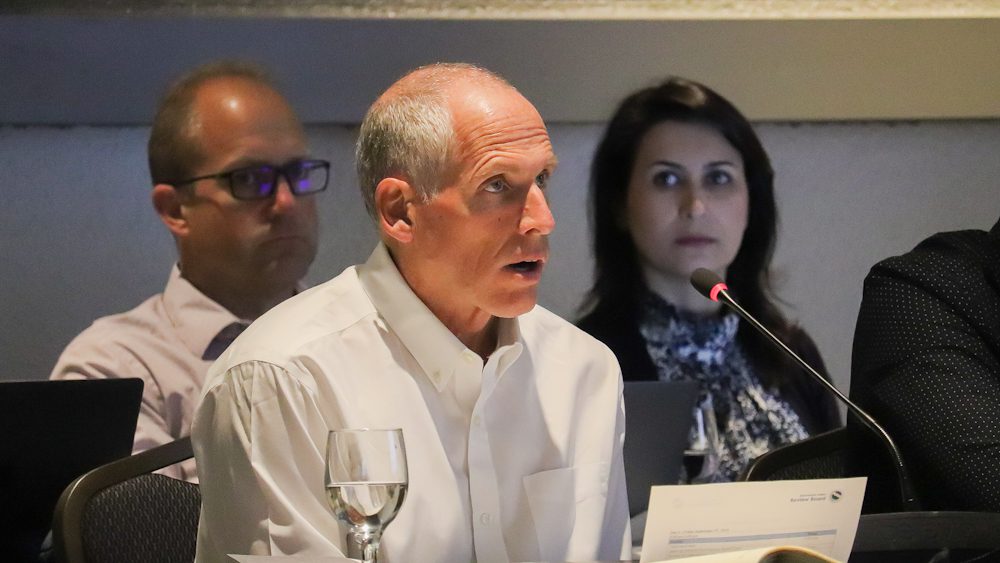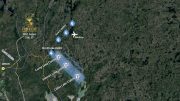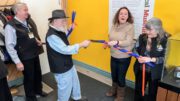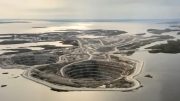How important are the perceived effects of development on the land?
That was one of the main questions at a public hearing on a possible change to Diavik mine’s closure plan.
The project
The mine is hoping to stuff 5 million cubic metres of processed kimberlite back into one of its pits.
According to Gord Macdonald, the manager of the mine’s closure, the idea came from discussions with a traditional knowledge panel that said it would like to reduce the mine’s footprint above-ground.
During the hearing hosted by the Mackenzie Valley Environmental Impact Review Board (MVEIRB), Macdonald said several times that Diavik believes this would be the safest place for the processed kimberlite long term.
It also happens that storing the kimberlite underground would be cheaper than building up dikes—the alternative if this project isn’t allowed.
The idea is relatively simple: In 2022, the mining in the A418 pit will be complete, it would then be backfilled with processed kimberlite and would be capped through meromixis (a fancy word that means the water near the kimberlite wouldn’t mix with the water near the surface of the lake because of the difference of chemistry, like it being saltier), the dikes would then be breached allowing Lac de Gras to cover the pits. Diavik says this would be stable enough to ensure the top 40 metres of the water column (where it assumes most fish will live) would be safe for fish and wildlife. However Macdonald confirmed that deeper than 40 metres, the water may not meet quality benchmarks.
For this project to be allowed, the project has to be approved by the MVEIRB and the Wek’èezhìi Renewable Resources Board. If the boards don’t approve the project, then Diavik would be forced to build the dikes currently keeping Lac de Gras at bay from its processed kimberlite containment facility.
According to Sean Sinclair, the superintendent of the mine’s environment team, the maximum height for the kimberlite containment facility is 473 meters in elevation; it’s currently at 465 meters.
Macdonald said the mine needs to make a decision on whether it will put the kimberlite underground or expand the containment facility sometime next year, otherwise the containment facility would be full by November 2021.
The Diavik representatives were asked if they’d ever consider simply stopping the operation and closing the mine earlier than 2025, but they replied that wasn’t in the plans.
(Below are two slides from Diavik’s public presentation. The full presentation, along with those of the interveners can be found here)
DiavikKimberlitePresentation1-rotated DiavikKimberlitePresentation2-rotatedPerceived effects up to communities
Ginger Gibson, a consultant with Tłı̨chǫ Government, said elders in the communities have said that they were unlikely to use the area if the project was to go ahead, knowing it was a remediated mine.
Macdonald said Diavik couldn’t anticipate what the perceived effects of the project would be on cultural practices in the area. He put the onus on the communities to share those concerns.
Patrick Simon is a councillor and deputy mayor for Deninu K’ue First Nation (Fort Resolution). He pushed Macdonald and other Diavik representatives to see the project from his “worldview”: not based on numbers and percentages but if the water was clean enough to use.
Macdonald said he’d prefer using the term “safe” rather than “clean” but reassured Simon that the modelling Diavik had done so far showed the water would be safe.
Enough information?
But that reliance on the modelling was another sticking point during the hearing. Macdonald said Diavik would undertake a whole new series of more detailed modelling if the project was approved.
Lauren King, Lands Manager for Łutsel K’e Dene First Nation, was one of many interveners that asked why Diavik hadn’t done the full assessment before applying for the change to the water license.
Macdonald said this first round of modelling was to establish if the project was viable. He later added that he believed interveners and the MVEIRB had enough information to make a proper assessment.
King pushed back saying that more detailed modelling would allow communities to better evaluate the project. She also asked if the new modelling showed bad outcomes for water quality if Diavik would abandon the project. Macdonald said the mine wouldn’t go ahead with the kimberlite backfilling if that was the case.
The decision ultimately rests with the Government of the Northwest Territories’ Minister of Lands. With an election on the horizon, the person who will make that decision is unknown.
If the project was to get the OK, Diavik would be responsible for monitoring the water near the pits, but it’s not clear for how long. Macdonald expects it would be in the 10 to 20-year range, but the amended water license will dictate exactly how long that would be.
Patrick Simon from Deninu K’ue said the mine is responsible for the land it developed and should be “from the cradle to the grave.”
Additional info:
- This project would only see a fraction of the total processed kimberlite go underground. So far the mine has 32 million cubic meters of the stuff, it would only put 5 million cubic meters in the pit.
- As part of its license amendment application, Diavik wants to have the ability to put processed kimberlite in its A154 pit once the mine is closed but is not currently planning on doing so.
- The average depth of Lac de Gras is 12 metres.










